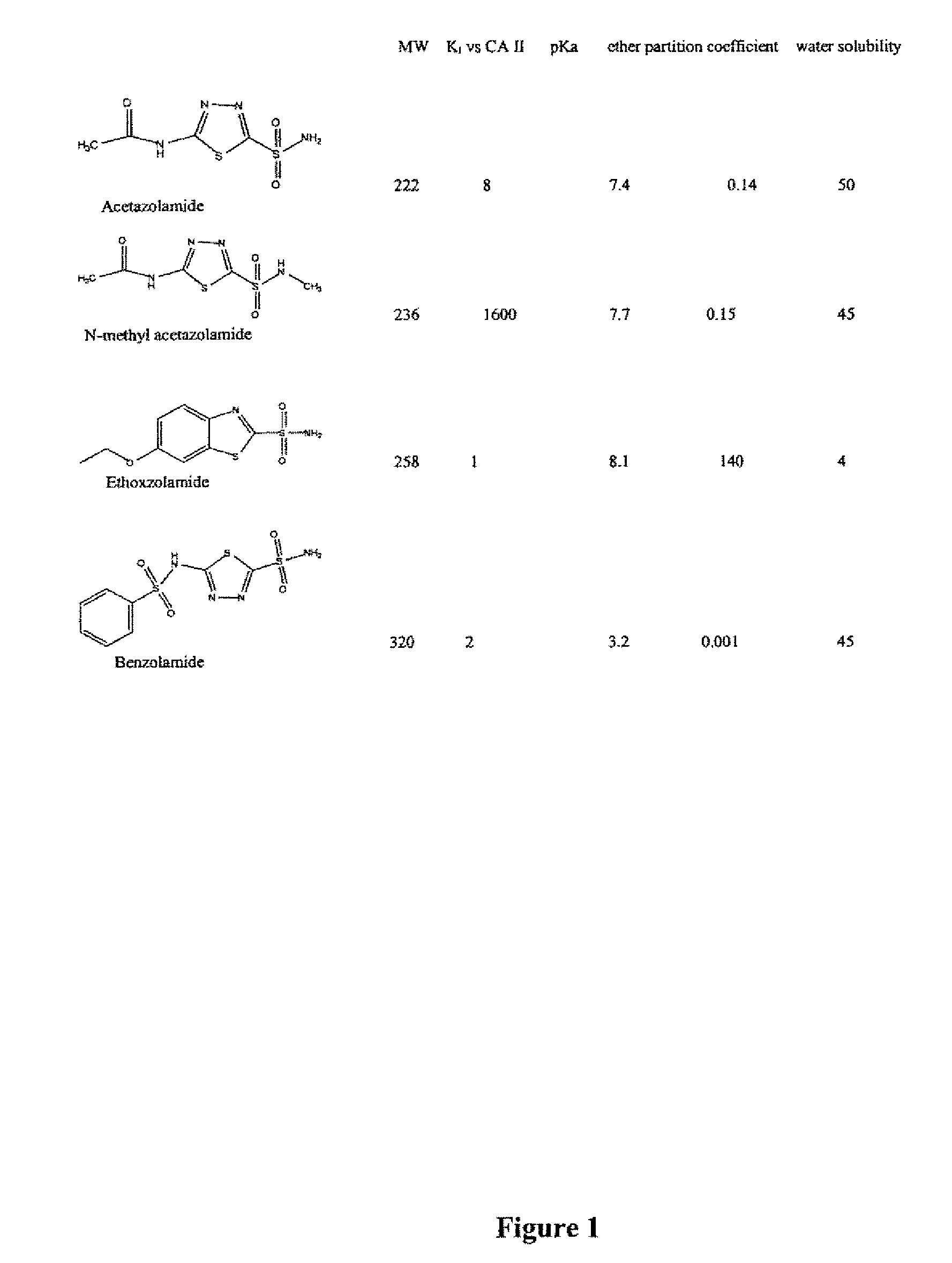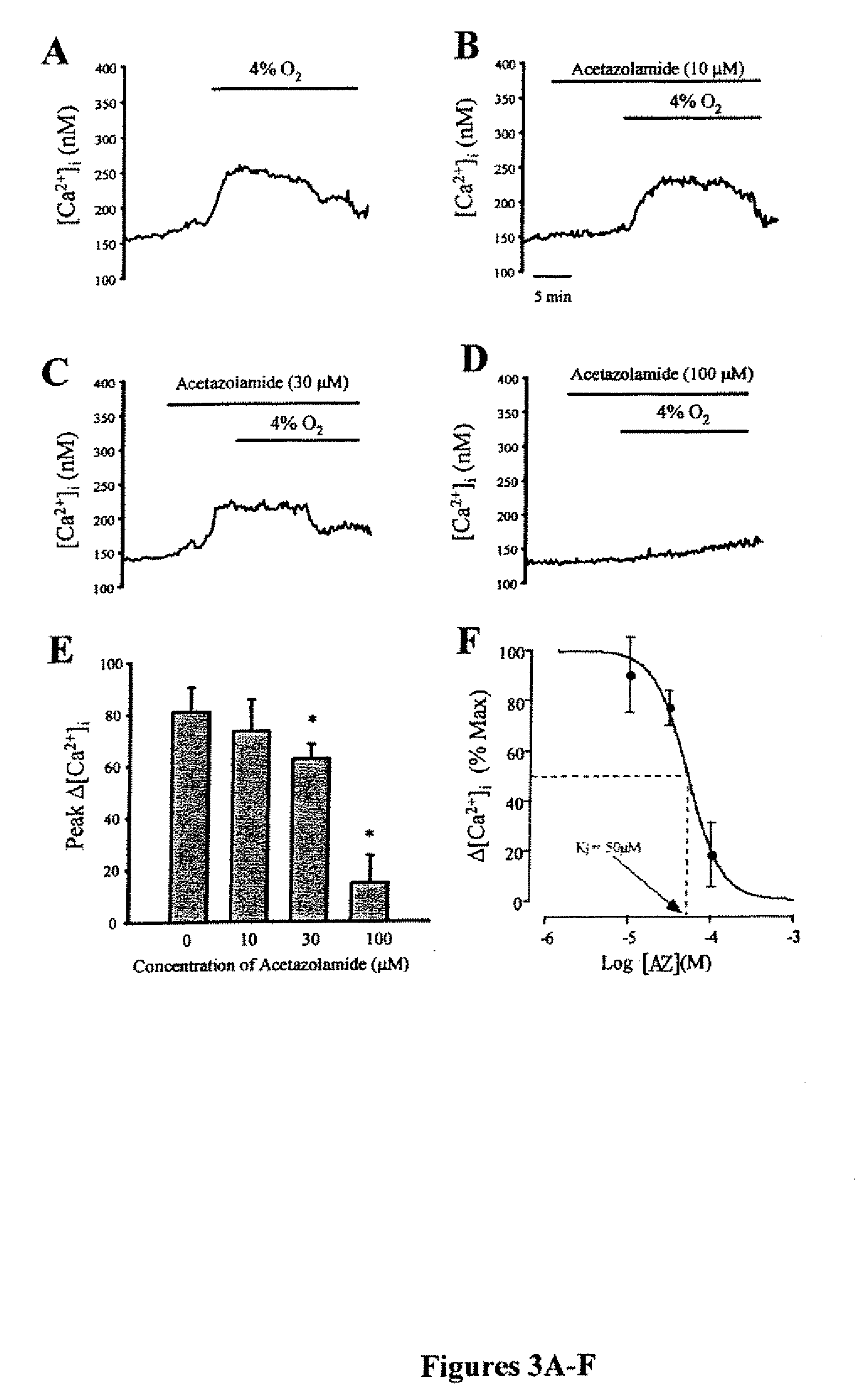Methods of treating pulmonary disease using acetazolamide and structurally related derivatives
a technology of which is applied in the field of methods of treating pulmonary disease using acetazolamide and structurally related derivatives, can solve the problems of complex course of patients with chronic cardiopulmonary disease, and the exact cellular mechanisms by which hypoxia induces hpv remain poorly understood, and achieve rapid and reversible increase in [ca2+]i
- Summary
- Abstract
- Description
- Claims
- Application Information
AI Technical Summary
Benefits of technology
Problems solved by technology
Method used
Image
Examples
example 1
Isolation of Pulmonary Artery Smooth Muscle Cells (PASMC)
[0046]The method for obtaining single PASMCs has been described previously in Shimoda L. A., et al., Am J Physiol 274: 842-853 (1998), which is hereby incorporated by reference in its entirety. Intrapulmonary arteries (200-600 μm o.d.) were isolated from male Wistar rats (250-350 g) and cleaned of connective tissue. After the lumen was gently rubbed with a cotton swab to remove the endothelial cells, the arteries were allowed to recover for 30 minutes in cold (4° C.) HBSS containing (in mM): 130 NaCl, 5 KCl, 1.2 MgCl2, 1.5 CaCl2, 10 N-[2-hydroxyethyl]piperazine-N′-[2-ethanesulfonic acid] (HEPES) and 10 glucose, with pH adjusted to 7.2 with 5 M NaOH, followed by 20 minutes in reduced-Ca2+ (20 μM CaCl2) HBSS at room temperature. The tissue was enzymatically digested in reduced-Ca2+ HBSS containing collagenase (type I; 1750 U / ml), papain (9.5 U / ml), bovine serum albumin (2 mg / ml) and dithiothreitol (1 mM) at 37° C. for 20 minutes...
example 2
Measurement of [Ca2+]i
[0047]The methods for measurement of [Ca2+]i have been described previously in Wang J., et al., Am J Physiol Lung Cell Mol Physiol 288: L1059-1069 (2005), which is hereby incorporated by reference in its entirety. Acute hypoxia increases intracellular [Ca2+] in pulmonary arterial smooth muscle by enhancing capacitative Ca2+ entry. Briefly, PASMCs were placed in a laminar flow cell chamber and perfused with modified Kreb's bicarbonate solution containing (in mM): 118.3 NaCl, 4.7 KCl, 1.2 MgSO4, 25 NaHCO3, 1.1 glucose and 1.2 KH2PO4. [Ca2+]i was measured in cells incubated with 5 μM Fura-2 AM for 60 min at 37°, then washed with PSS for 15 min at 37° C. to remove extracellular dye and allow complete de-esterification of cytosolic dye. Ratiometric measurement of fluorescence from the dye was performed on a workstation (Intracellular Imaging Inc, Cincinnati, Ohio) consisting of a Nikon TSE 100 Ellipse inverted microscope with epi-fluorescence attachments. The light...
example 3
Measurement of pHi
[0048]pHi within PASMCs was monitored using the cell permeant pH sensitive dye 2′,7′-bis(carboxyethyl)-5(6)-carboxyflourescein (BCECF-AM). Cells were incubated with BCECF-AM for 60 min at 37° C. under an atmosphere of 21% O2-5% CO2. Cells were then washed with Kreb's solution for 15 min at 37° C. to remove extracellular dye and allow complete de-esterification of cytosolic dye. Cells were excited with light at 490 and 440 nm and light emitted from the cells was detected at 530 nm. The ratio of 490 to 440 nm emission was calculated and converted into pH values by performing a calibration curve after each experiment. PASMCs were subjected to a high K+ buffer containing 10 μM nigericin, which allowed the cell to adopt the pH of the high K+ buffer. Two high K+ / nigericin buffers were used to set pH to 6.5 or 7.5, pHi was estimated from in situ calibration after each experiment. Cells were perfused with a solution containing (in mM): 105 KCl, 1 MgCl2, 1.5 CaCl2, 10 gluc...
PUM
| Property | Measurement | Unit |
|---|---|---|
| diameter | aaaaa | aaaaa |
| diameter | aaaaa | aaaaa |
| altitude | aaaaa | aaaaa |
Abstract
Description
Claims
Application Information
 Login to View More
Login to View More - R&D
- Intellectual Property
- Life Sciences
- Materials
- Tech Scout
- Unparalleled Data Quality
- Higher Quality Content
- 60% Fewer Hallucinations
Browse by: Latest US Patents, China's latest patents, Technical Efficacy Thesaurus, Application Domain, Technology Topic, Popular Technical Reports.
© 2025 PatSnap. All rights reserved.Legal|Privacy policy|Modern Slavery Act Transparency Statement|Sitemap|About US| Contact US: help@patsnap.com



